When I began this newsletter last July, it was with a promise to myself: to write weekly for a year and see where it would lead. And, here we are. Sipping Italy with Tino is nearing the end of its weekly rhythm. While I’ll still be sharing stories, they’ll arrive occasionally, like postcards, rather than in a steady stream. In fact a few entries are already taking shape, and I look forward to continuing the journey with you—just at a different pace.
But before I shift gears, there’s one story I need to tell—the one that brought me here in the first place.
In October 2022, I set out alone on a segment of the Via Francigena, the ancient pilgrimage route that threads its way through the soul of Italy. It was a solitary walk. And a transformative one. The most profound journey I’ve ever taken. To draw the curtain on this chapter of my newsletter, without sharing that walk would feel like leaving a stone unturned. And so, in this post and continuing into next week, I want to share the journey that led me here—the most personal one of all.
What is the Via Francigena?
The Via Francigena is a pilgrimage route that dates back to the 10th century. It stretches from Canterbury, England, to Rome—roughly 2,000 kilometers—and was first recorded by Sigeric, the Archbishop of Canterbury, who walked it to receive his papal blessing. Over the centuries, it served as a corridor through Europe for pilgrims, merchants, messengers—anyone drawn toward the spiritual and political heart of Christendom.
It isn’t a single road, but a patchwork of trails, forest paths, farm tracks, and quiet lanes. It crosses the English Channel, winds through France and Switzerland, over the Alps, and down into the rolling hills of Italy.
Today, people walk the Francigena for all sorts of reasons. Some for faith. Some for the physical challenge. Many—like I did—for the quiet space to think, to process, to heal. It’s a slow road. One that teaches you to pay attention—to your steps, your thoughts, the rhythm of your breath, and the changing sky overhead. The Tuscan section of the Via is one of the most popular ones amongst pilgrims.
Why I Needed to Go
It was spring 2022, and the world was just beginning to emerge from the fog of the Covid pandemic. Emotionally, I wasn’t in a good place. After two failed marriages and nearly 40 years in long-term relationships, I found myself unmoored—no longer sure of who I was or what I wanted. The life I had built, had come apart more than once, and now felt too heavy for the unsettled, searching person I had become.
That year, I worked with a therapist who gave me the tools I needed to move forward. To take a leap, as it were.
There are many things that draw me to Italy. I had been many times before, but always for short stretches. This time, I wanted more than a visit. I wanted to live it. I was searching—blindly, but with a quiet hope that maybe, just maybe, returning to the land I had left as a child might help me find a way back to myself.
Somewhere in the middle of that restless search—digging through maps, blogs, and guidebooks—I stumbled upon a mention of the Via Francigena. Italy’s answer to the Camino de Santiago, they said. The more I read, the more it called to me.
So, I began to prepare—not just for a trip, but for a journey. One that might give me some answers or change certain things in ways I didn’t yet know.
Between Leaving and Going
I booked a one-way ticket to Rome for September 17th. I’d visit my birth village for a few days, then settle into a short-term apartment in Colle Val d’Elsa, a small town in Tuscany. The idea was simple: spend a month exploring, biking, and living the local life. After that, I’d begin the pilgrimage. The goal: to walk from Colle to Rome. Sixteen days. About 21 kilometers a day.
Once I reached Rome, I’d decide whether to return to Montreal or keep wandering—maybe into another country.
To train, I loaded weights into my pack and hiked the Saint-Sauveur mountains near home, gradually increasing the distance. I devoured everything I could find on the Francigena—books, forums, blogs—and slowly assembled my gear. Since I’d be walking from late October through mid-November, I packed for cold, damp days. Every extra layer added weight, but they were necessary.
I chose Colle Val d’Elsa for two reasons: its proximity to Siena, Florence, San Gimignano, and Gaiole in Chianti—where I had signed up for a vintage cycling event called L’Eroica—and because the Airbnb listing showed a large terrace, abundant natural light, and was in walking distance to everything I’d need. Without a car, that mattered. Also I did not want a crowded tourist place, I wanted to live like a local. And so I did.
Blame the Light Switch
One evening, the countertop neon light in my apartment stopped working. The next morning, I called the owner, Emanuela. She was friendly and offered to stop by after closing her art gallery that evening.
As it turned out, the light was fine—I just hadn’t found the switch. Still, it gave us a chance to get acquainted. We shared a glass of Chianti from a bottle already open on the kitchen table.
Over the next few days, we saw each other often, and she introduced me to her friends. We went to the movies. She showed me some of her favorite restaurants in and around town. There was an undeniable connection between us.
The month in Colle went by quickly. Mostly, I was settling into a feeling I hadn’t known in a long time—that of being in a place that felt familiar, like somewhere I’d always carried in my head. It just fit. It felt good. There was a sense of freedom I had seldom experienced. It felt like home.
Since the plan was to book a flight from Rome—either back to Montreal or somewhere else—I had arranged for my cousin Sergio, who lives in Rome, to receive the suitcase of personal belongings I shipped to him the day before my departure. That left me with only my 12-kilo backpack and my gear.
I’m not sure whether I was being cautious or just looking for an excuse to stay connected, but before I left, I asked Emanuela if she’d mind having access to my location through the iPhone app—just in case I fell into a ditch somewhere and no one knew where I was, or got attacked by a wild boar.
She agreed without hesitation. In return, she asked if I’d send her a photo of every room I stayed in during my walk. The request felt strange, but I didn’t ask questions. I agreed I would.


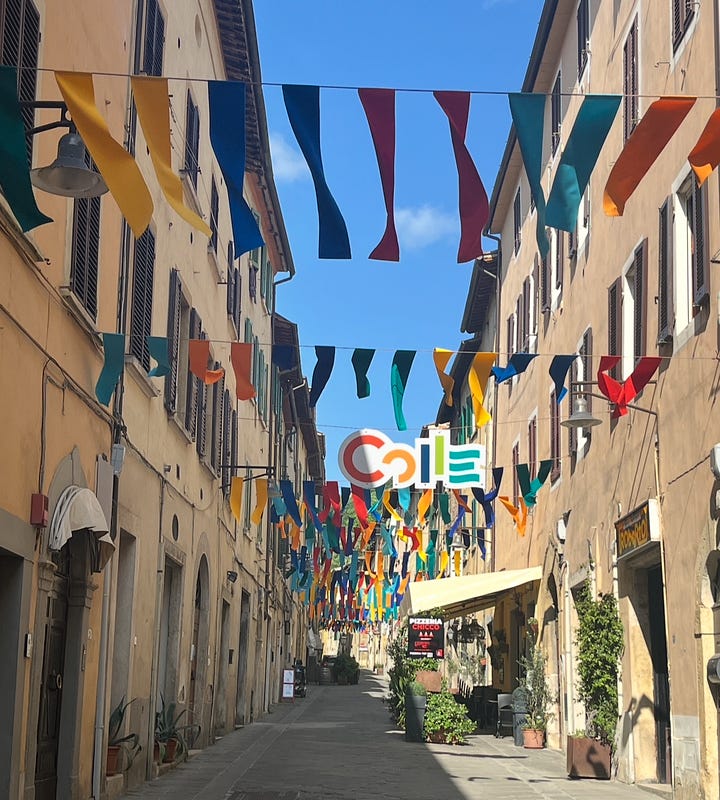


The Pilgrimage:
Day 1 - October 21
To Monteriggioni- 26 km.
I left Colle Val d’Elsa under a cloudy Tuscan sky, backpack heavy, heart light. Excitement pulsed in my veins as I passed familiar terrain, heading toward Monteriggioni. My spirit was high. I was finally walking the path I had dreamed of.
Three hundred and forty kilometers lay ahead. I didn’t know what I would find—but I was ready to search. Rome felt far away, but I wasn’t thinking about the finish-line. I wanted to savor every kilometer. I was walking for peace, for clarity. Maybe even for transformation.
The countryside unfolded gently, its curves and olive groves reminding me why I loved Tuscany. About halfway through the day, near Strove, I met Fabrizio and Elena, a kind couple from Trentino celebrating their 25th wedding anniversary with a weekend walk on the Francigena. We shared stories and footsteps for a few hours before parting ways.
Fatigue crept in slowly but steadily. My feet were sore, and by the time I reached Monteriggioni—a medieval jewel still enclosed in its ancient walls—I was exhausted. I rewarded myself with a gelato, savoring the sweet coolness like a blessing.
But the day wasn’t done.
My first sleeping accommodation was a few kilometers past the village. I had planned my timing perfectly—hoping to arrive in mid-afternoon for a well-deserved rest. Since there were no restaurants or grocery stores nearby, I called the Airbnb host to ask about dinner. She kindly offered to pick up a pizza on her way home from work.
I followed the GPS to the address and arrived at a surprisingly grand villa. I was stunned. Wow, what 35 euros could get you! It looked uninhabited, but the grounds were pristine. In the adjacent building, I spotted some people. “Scusa, è questo il Marchi Gallinaio Airbnb?” I asked a gentleman arranging fine herbs in a straw basket.
“Hm! You’ve got the wrong place, my friend,” he replied. “We have the same name, but the Airbnb is about four kilometers in the other direction.”
I wanted to die.
First, it meant adding eight kilometers to my already long first day. Second—was I not going to sleep in this dreamy place and instead live the real pilgrim life?
I finally reached the correct lodging, tucked into the countryside, around 5:30 pm completely spent. It was adequate, but a far cry from the other Marchi Gallinaio. I mean, Italians are so creative… why on earth would they use the same name? Who copied whom?
The landlady showed up a couple of hours later with a cold pizza, which I devoured. I collapsed onto the sofa and put my feet up. Beneath the physical exhaustion, I felt elated.
The pilgrimage had begun.

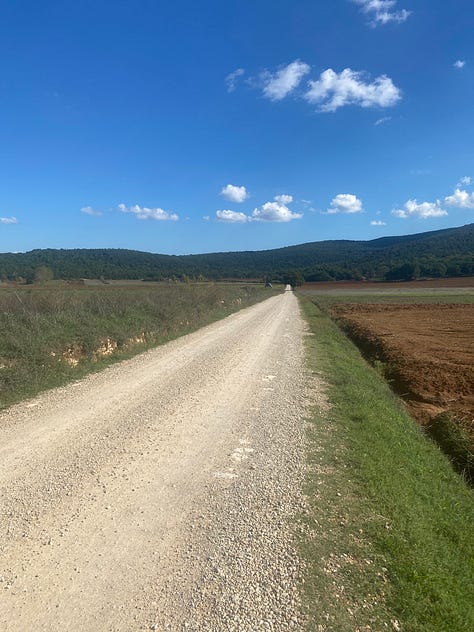
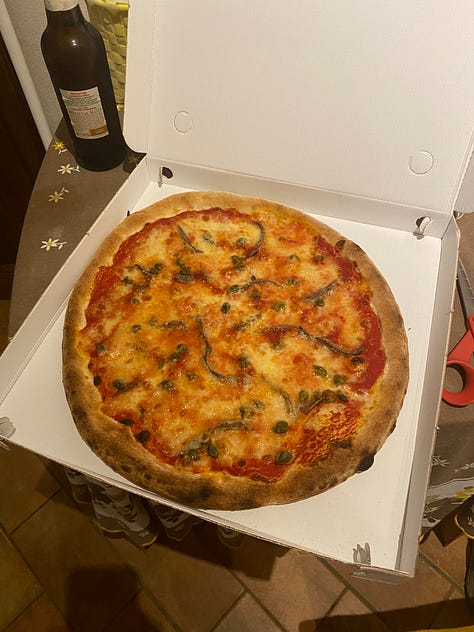
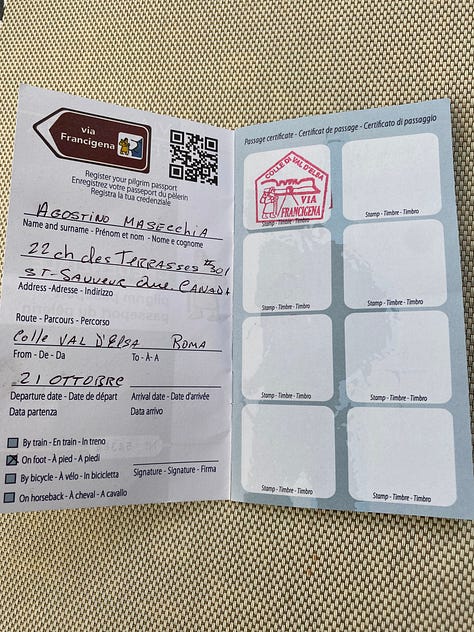
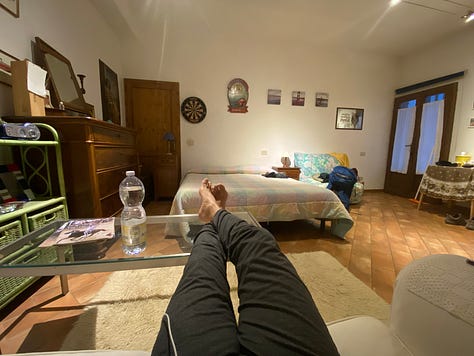

Day 2 – October 22
To Siena, 18 km. Total: 44 km
I woke up around 6:00 am to a sore heel and the hush of an overcast Tuscan morning. Breakfast was included, but let’s be honest—coffee and fette biscottate (rusks) won’t get me far. One thing Italians aren’t big on is breakfast. I wake up famished! What’s wrong with these people?
I took my time leaving, knowing I only had 18 kilometers ahead. The trail curved gently through vineyards and cypress-lined paths, and I moved slower today, letting Siena draw me in. My body was learning the rhythm of the walk—the difference between fatigue and injury, discomfort and pain.
Reaching Siena lifted my spirits. The streets buzzed with students and tourists, their energy pulsing through the narrow lanes. At the monastery of San Clemente dei Frati, I had a private room and a panoramic view of the city. The campanili lit up the skyline as night fell. There was a strange, monastic peace in that space—solitary, cavernous, and oddly comforting. I was happy I didn’t have to share my room with other pilgrims.
That morning, during meditation, a thought had surfaced: how often we let time rule us, how rarely we just are. Here, now, away from routines and obligations, it dawned on me—I’ve been trying too hard to conform to other people’s standards instead of my own. It was a big revelation, one that landed solidly. I could feel my real self-rising to meet me.
Day 3 – October 23
To Monteroni d’Arbia, 18 km. Total: 62 km
I exited Siena by walking its ancient cobblestone streets and out through Porta Romana. Just outside the city walls, I stopped at the first coffee bar and had a more nourishing breakfast than the day before.
The landscape felt surreal. This part of Tuscany was new to me, and the novelty made time pass more quickly as I put one foot in front of the other. I walked for a stretch with two French couples. Curiosity always pulls me in—I want to know where people are from, how far they’re walking, what brought them here. But eventually, I slowly detach to continue my own pilgrimage and take in what’s around me more fully.
As I approached Monteroni, I noticed something sacred about Sundays in Italy. Even in a modest town like this—lacking the postcard charm of other Tuscan villages—there’s a quiet dignity in the stillness. People slow down. Life breathes a little deeper.
By early afternoon, my legs ached, my shoulders protested, and a blister was blooming on my heel. That’s when I realized I’d been wearing my backpack incorrectly—no wonder my shoulders were screaming. A simple adjustment brought instant relief. I reached the B&B on Piazza Gramsci by mid-afternoon. The rest felt good.
Each night, I would unpack my entire packsack and carefully put everything back in order the next morning. It began to feel like a travel companion. In fact, I gave him a name: Bacco.
Day 4 – October 24
To Buonconvento 15 km. Total: 77 km
I woke up early, eager to start the day. But as I stepped into the kitchen, Letizia—the host of the B&B—offered me a slice of apple cake she had baked. She began sharing stories about her writing and showed me how she had turned her modest condo into a haven for travelers. We chatted so easily, I didn’t realize how quickly time was flying by.
“Io non debbo viaggiare il mondo, il mondo viene da me,” she said.
“I don’t need to travel the world; the world comes to me.”
She had written several books about the people she’d hosted and their unique stories. Her warmth lingered with me long after I left.
The morning also brought pain. My blister throbbed, my shoulder ached, and my left knee reminded me that I’m no longer thirty. I hadn’t expected this level of physical strain so early in the journey—I thought the real complaints would start somewhere around the halfway point. But here I was, hobbling into Day 4.
I took it slow. Breaks became more frequent, especially as I entered the region of the Crete Senesi and Val d’Orcia—home to some of the most dramatic landscapes in Italy. One moment you're crossing clay hills, the next you're passing clusters of cypress trees and vineyards flanking golden wheat fields. This is the area where scenes from Gladiator were filmed.
The trail eventually brought me to Buonconvento, a charming medieval town where time seemed to have paused for a rest. Its narrow streets and ancient stones exuded a quiet, enduring beauty.
That afternoon, I met a young couple from Alsace—Caroline and Amel. We walked together for a while and kept bumping into each other at resting areas and cafés. We shared stories—especially those involving hiking and skiing—and they even invited me to come ski with them in the Alps. We exchanged contacts and stayed in touch throughout the journey. Their pace was a little faster than mine, so they began sending photos and clues about what was coming up ahead.
Later that day, I was lucky to find an open slot with a massage therapist just steps from my accommodation. I booked a session before dinner—it eased my aches and lifted my spirits. At the local farmacia, I picked up proper medicated bandages for my blister, which made walking bearable again. There’s a fine line on the Francigena between pushing through and listening to your body. I was learning to walk it—literally.
I remembered my therapist’s advice before I left: “Listen to your body. It will always warn you before it’s too late.”
On a quiet street in town, I found a restaurant serving Trippa Fiorentina, one of my all-time favorite dishes. I know tripe isn’t for everyone, but it brought back warm memories of my childhood—and it was delicious.
I didn’t sleep well that night—tossed and turned—but somehow, I still felt strong inside. Despite the pain, I ended the day with a quiet kind of joy. I was still moving forward. And for now, that was enough.
Day 5 – October 25
To San Quirico d’Orcia, 21 km – Total: 98 km
San Quirico d’Orcia is known for its Horti Leonini gardens from the Renaissance, and for Bagno Vignoni, an ancient thermal bath with a unique twist: instead of a central piazza, there’s a large stone pool from the Roman era, filled with steaming geothermal water. For centuries, it’s been a favorite spot for pilgrims to rest and heal.
This morning, the aches had migrated—my left thigh was now the loudest voice—but overall, I felt alright. I strapped on my knee braces like armor and stepped back onto the road.
But first my morning cappuccino. At the café, I ran into Caroline and Amel again. They mentioned they had met a woman from Montreal along the way—did I know her?
Not long after, someone with a strong French-Canadian accent ordered a cappuccino. I walked over and said, “Salut, comment ça va?”
Her name was Monique, and oddly enough, she lived in my old neighborhood back in Montreal. We walked together for a few hours, exchanging memories of the city. She too was heading to Rome, and before parting ways, we exchanged numbers—sure we’d run into each other again and trade restaurant or coffee shop tips along the road.
Solitude on the Via is not loneliness. It’s space. Space to think, or not think. To let the mind drift like a leaf on a stream. The weather was warm and golden, and the scenery... almost too beautiful to be real. I had the quiet realization that, at 67, I was living the dream I had at 10. And that’s not nothing.
I arrived at my lodging around 4:00 and had time to do a full wash at a laundromat. There’s something surprisingly satisfying about clean clothes when everything else feels worn. That evening, I wrote in my journal and sat with the strange contentment of being alone—and exactly where I needed to be. Alone in my thoughts, that is, as I hadn’t expected to meet so many interesting people—each carrying different stories, different reasons for walking, but in many ways, all seeking something in the same direction.
Of course, I was not completely alone, hearing from Emanuela each day on WhatsApp messages—little bursts of encouragement and reminders to photograph each room—made it feel like she was walking the journey with me, in her own supportive way.
Join me next Saturday as the journey continues. Will my body hold up? Will my mind stay steady? Will I make it to Rome? And why, exactly, does Emanuela want those pictures?






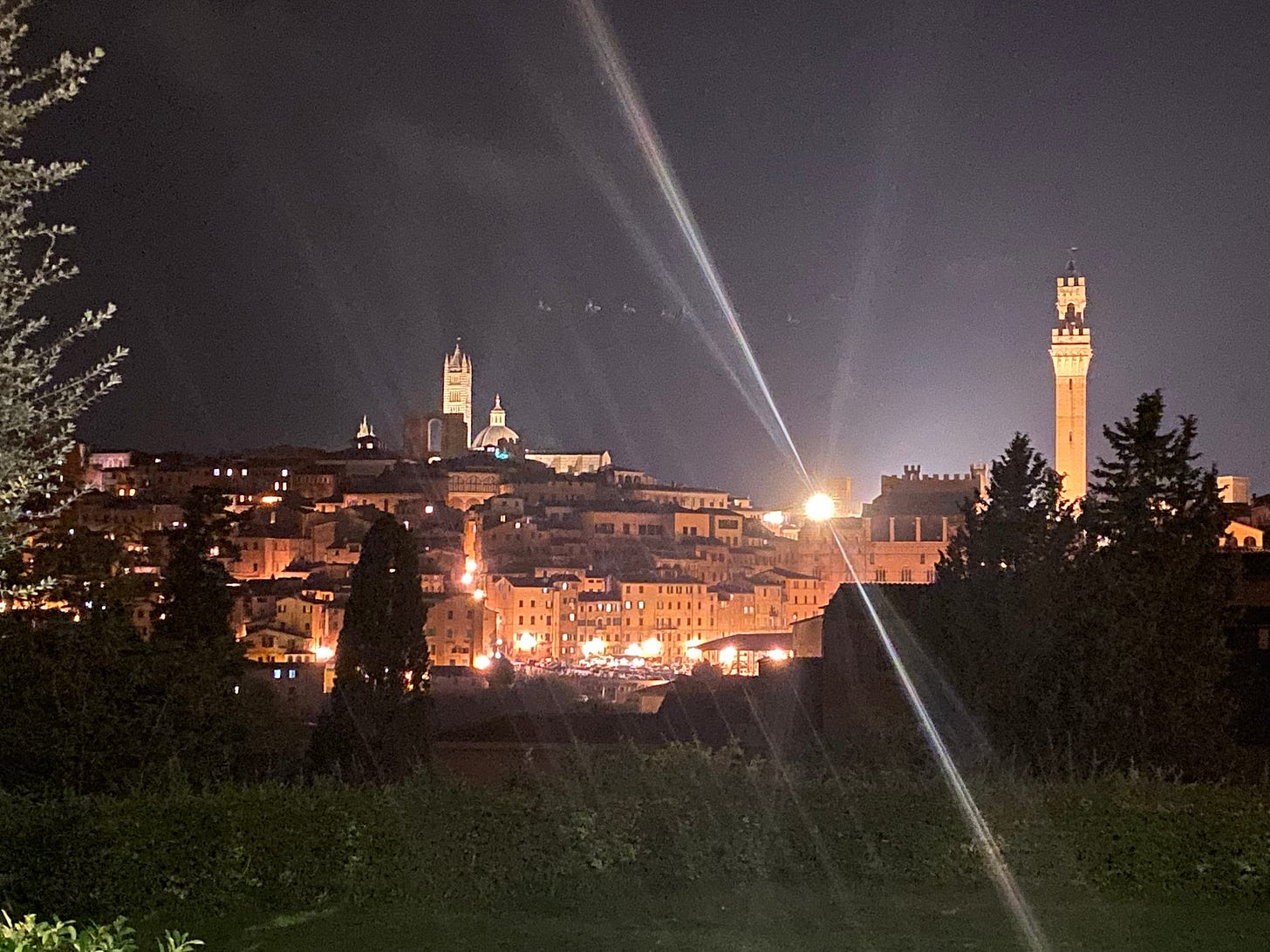

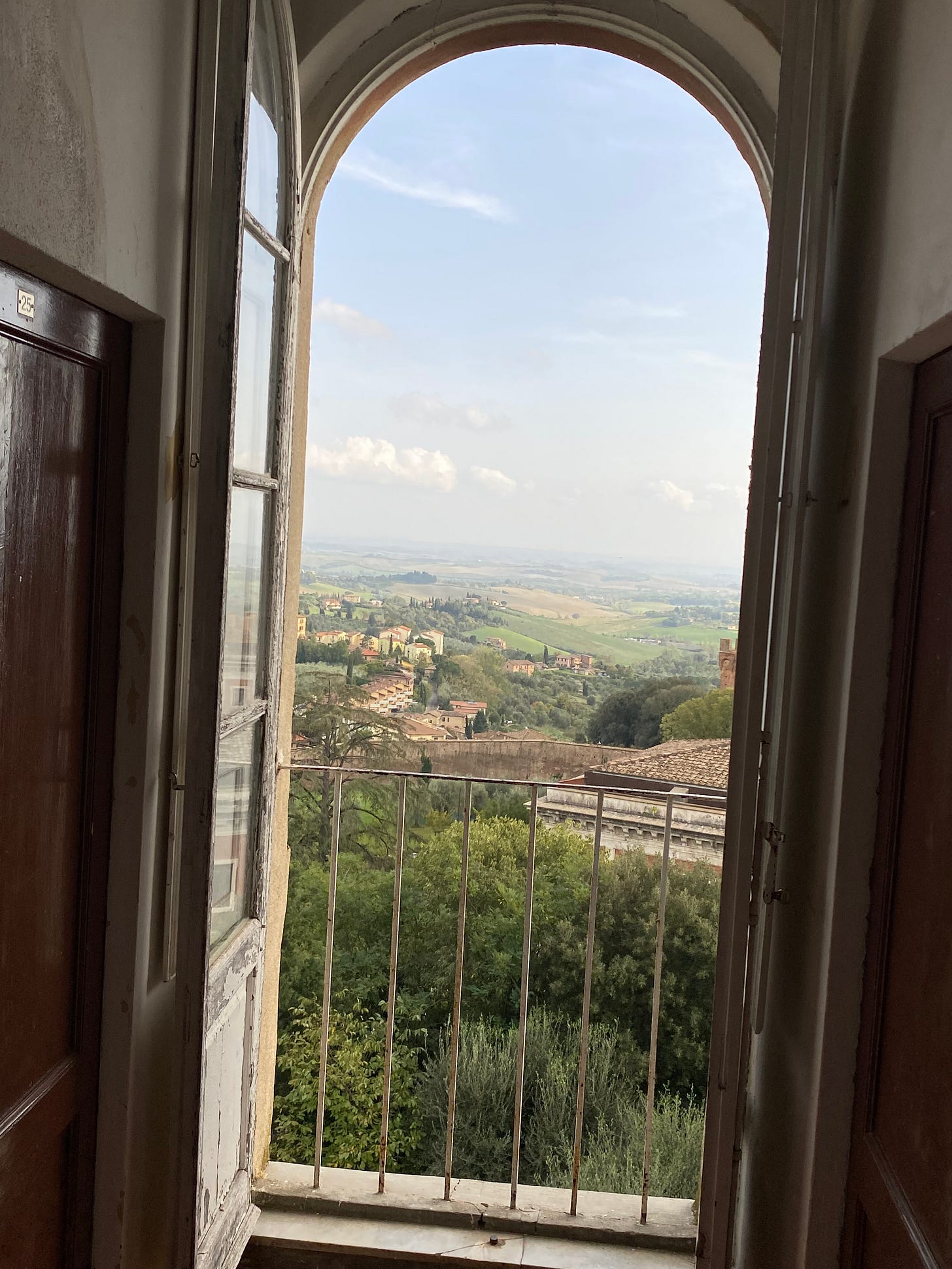


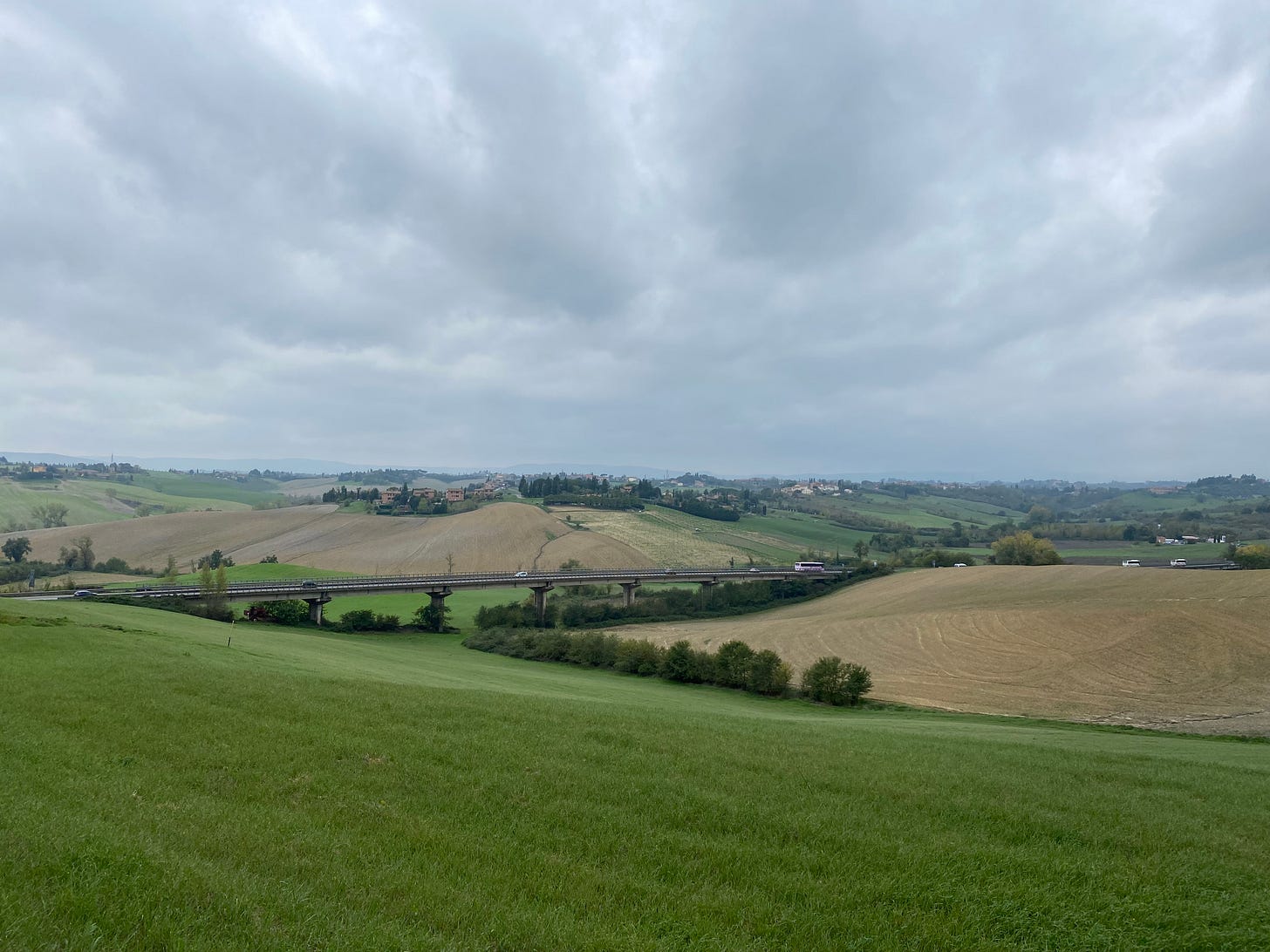
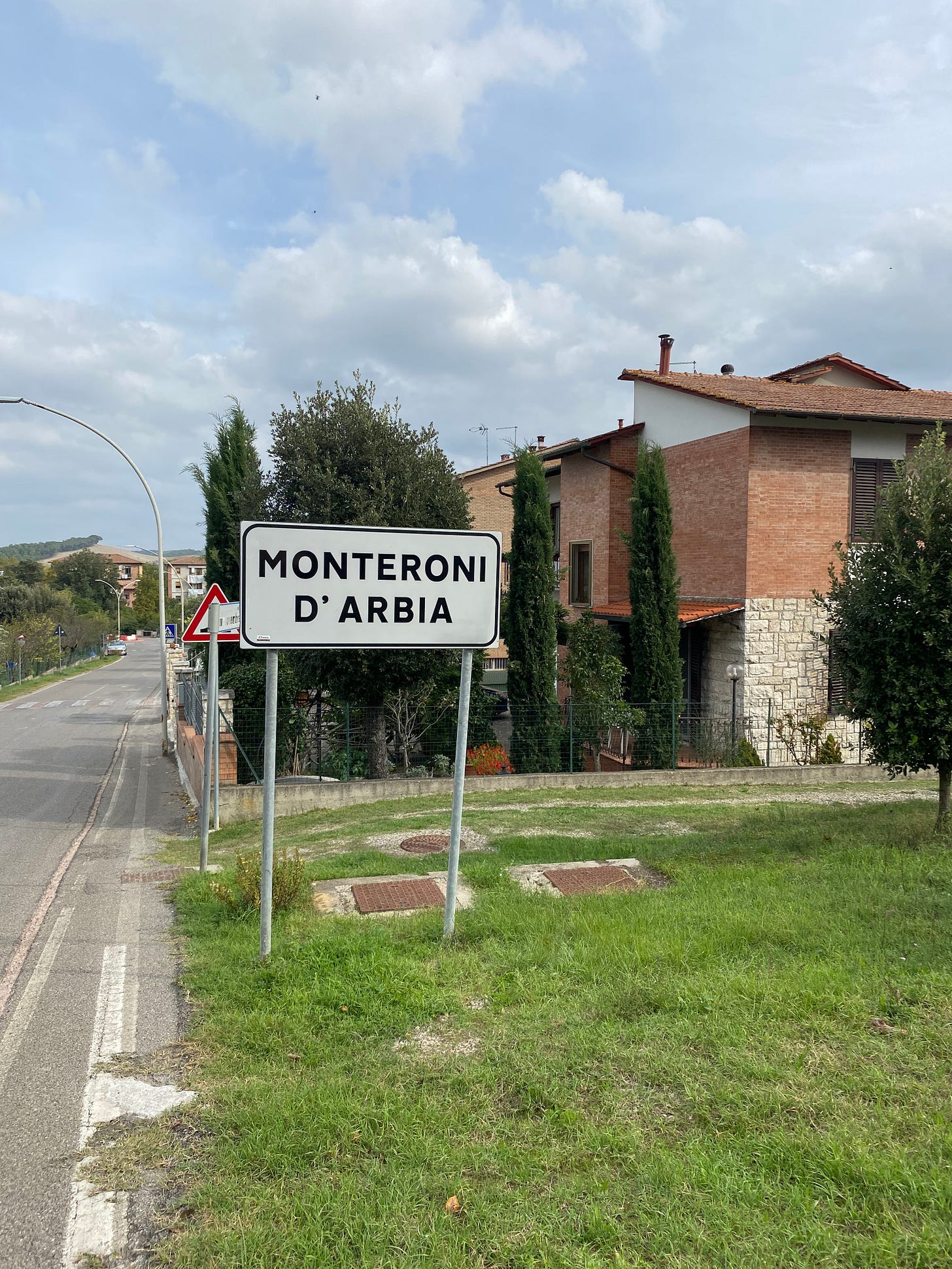


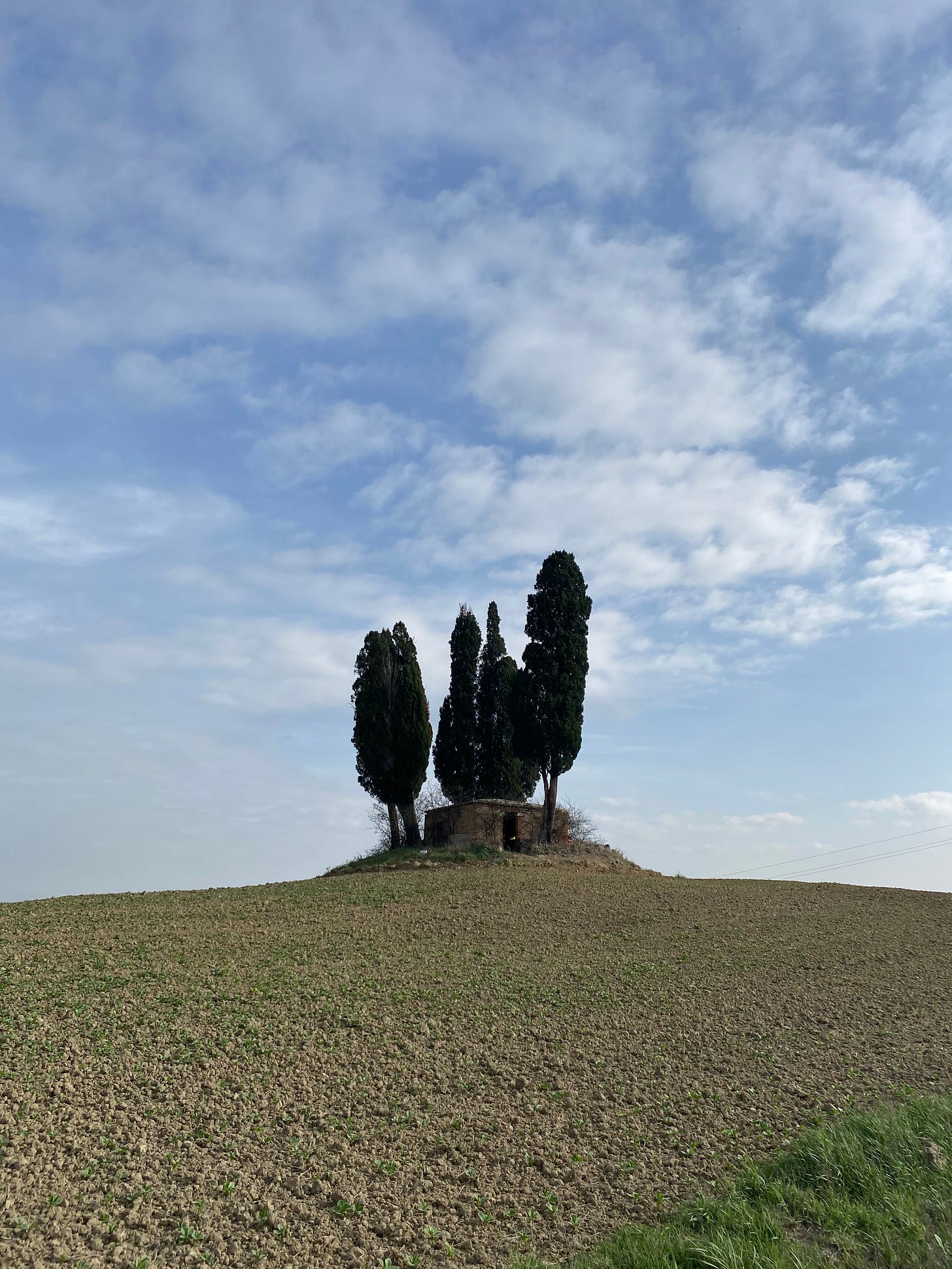



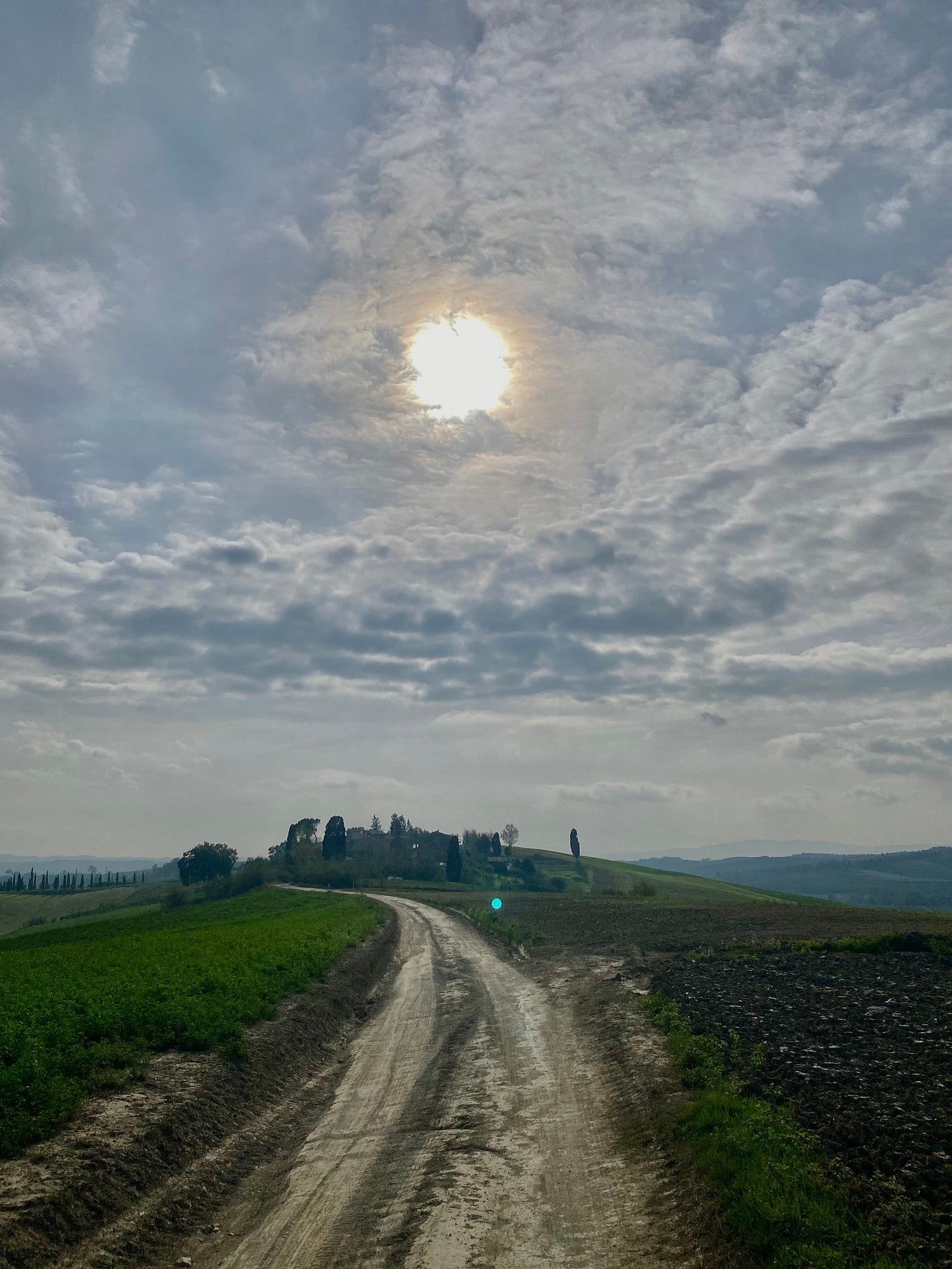
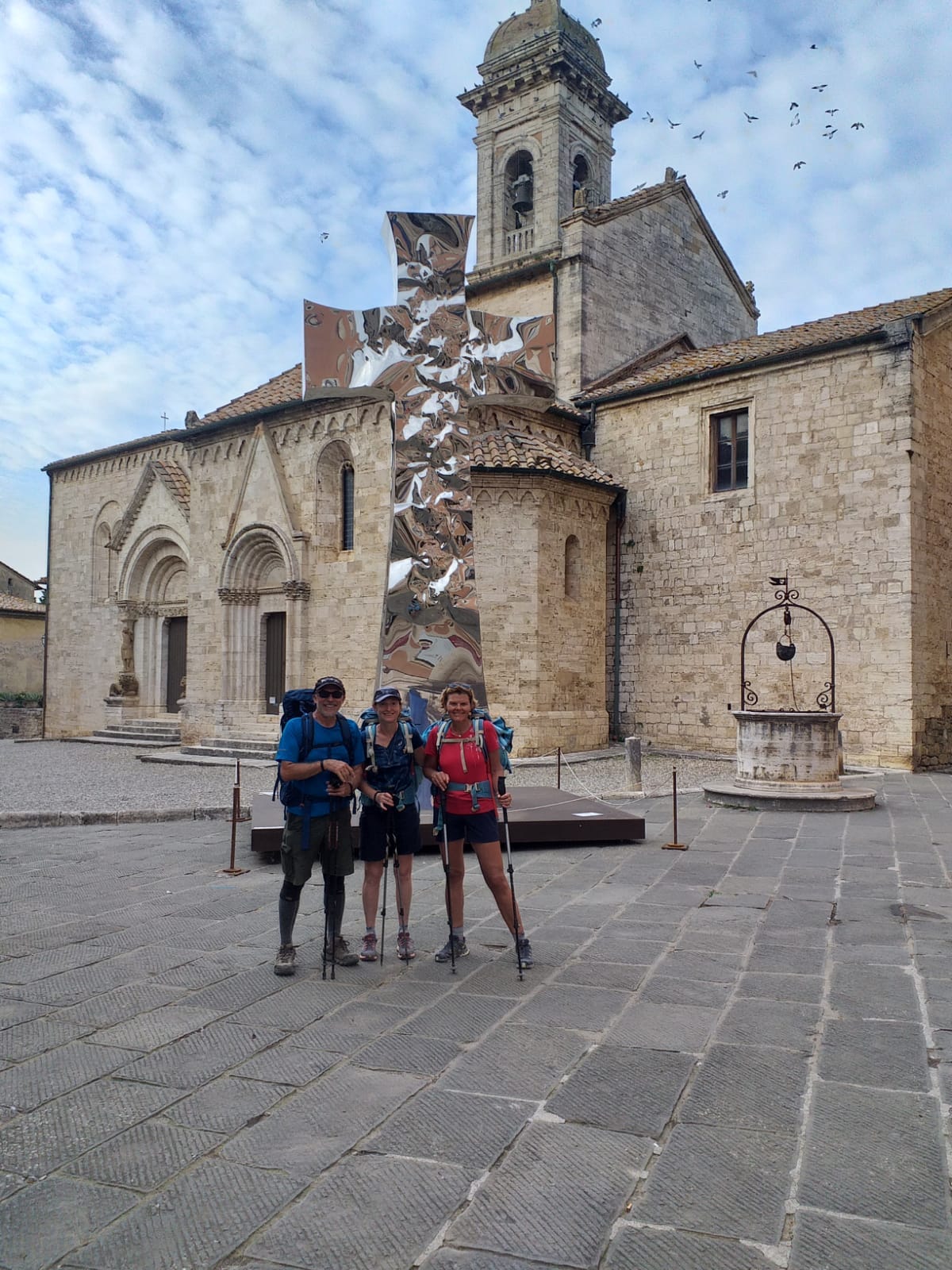

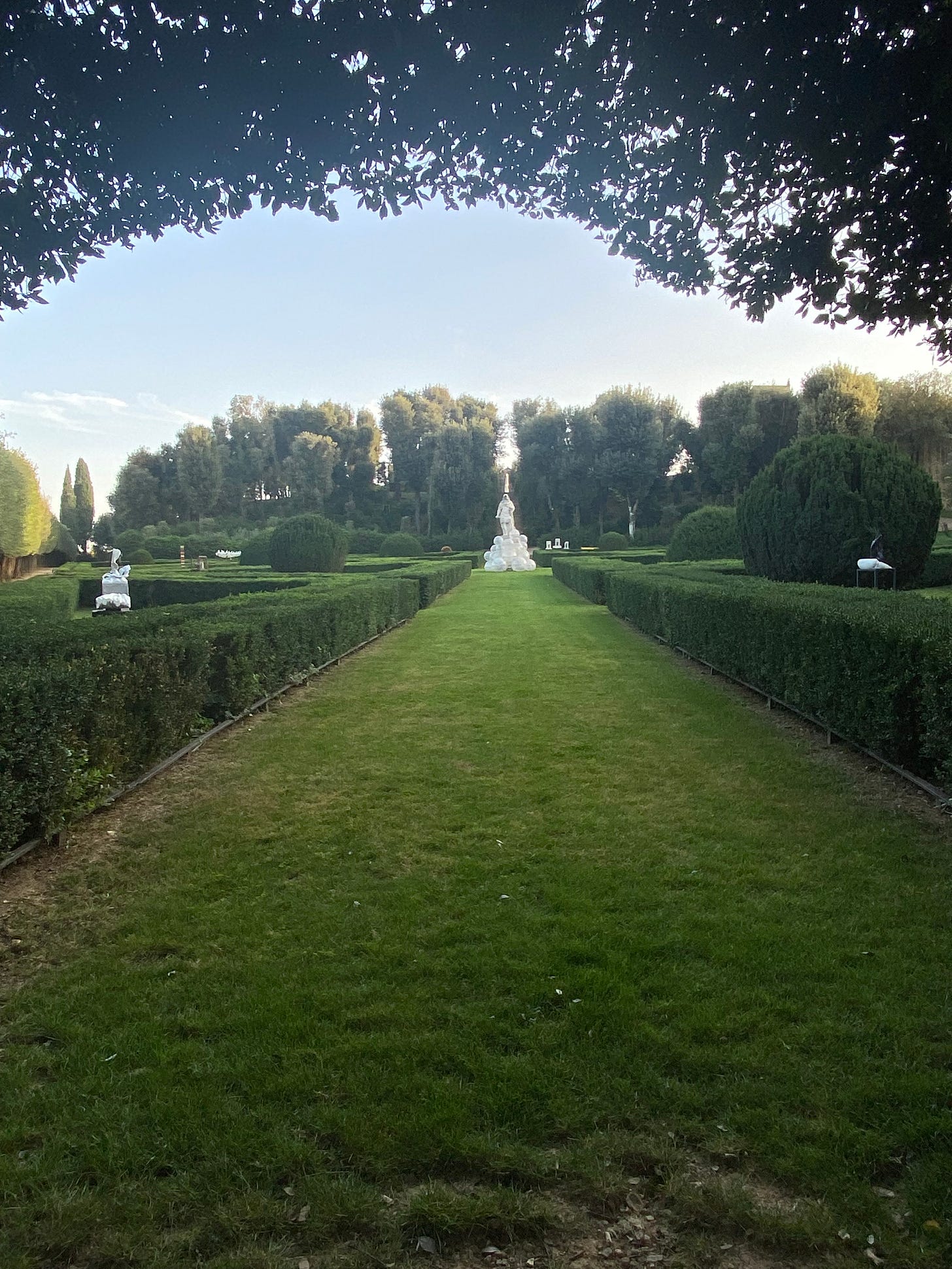
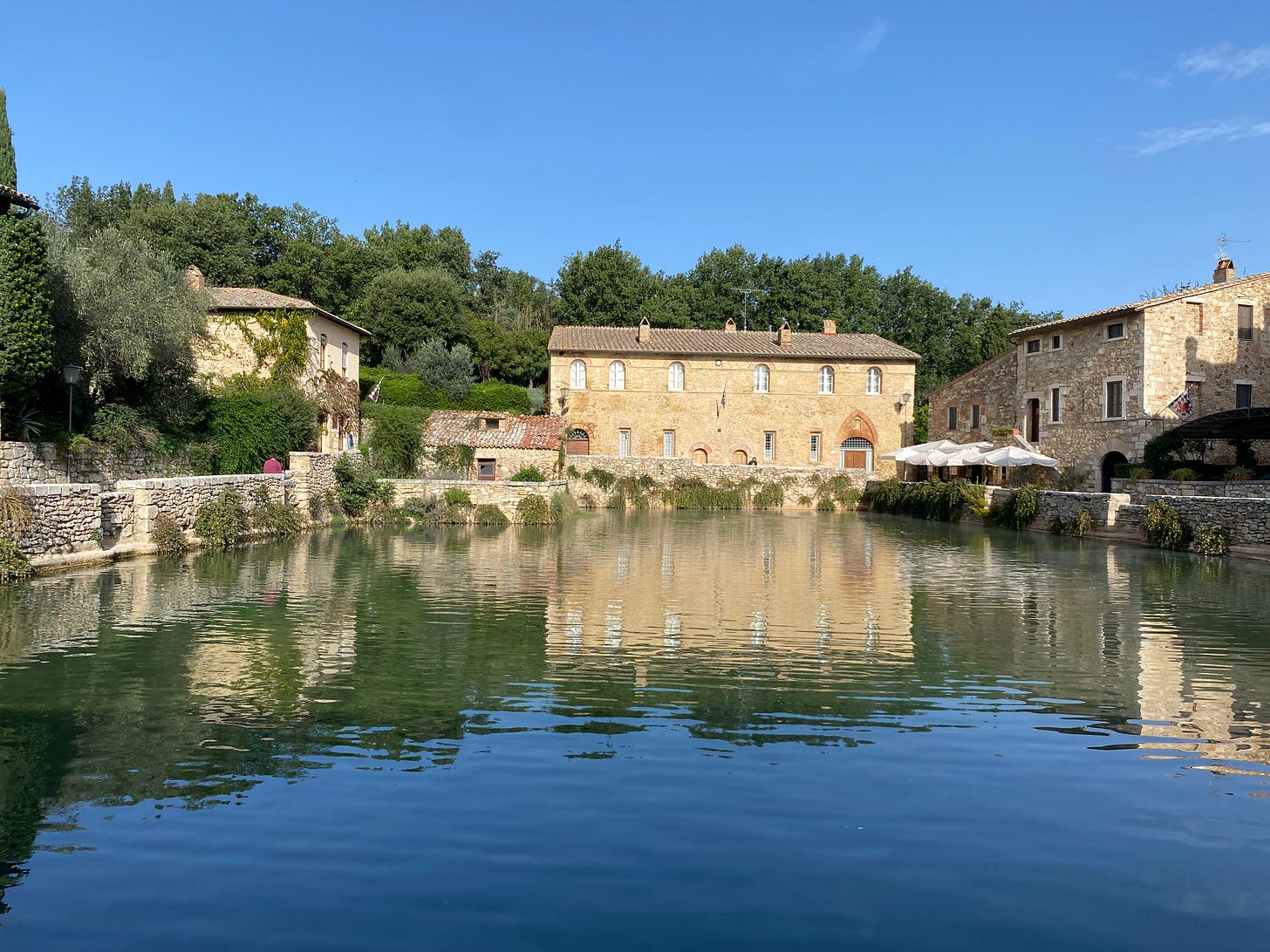
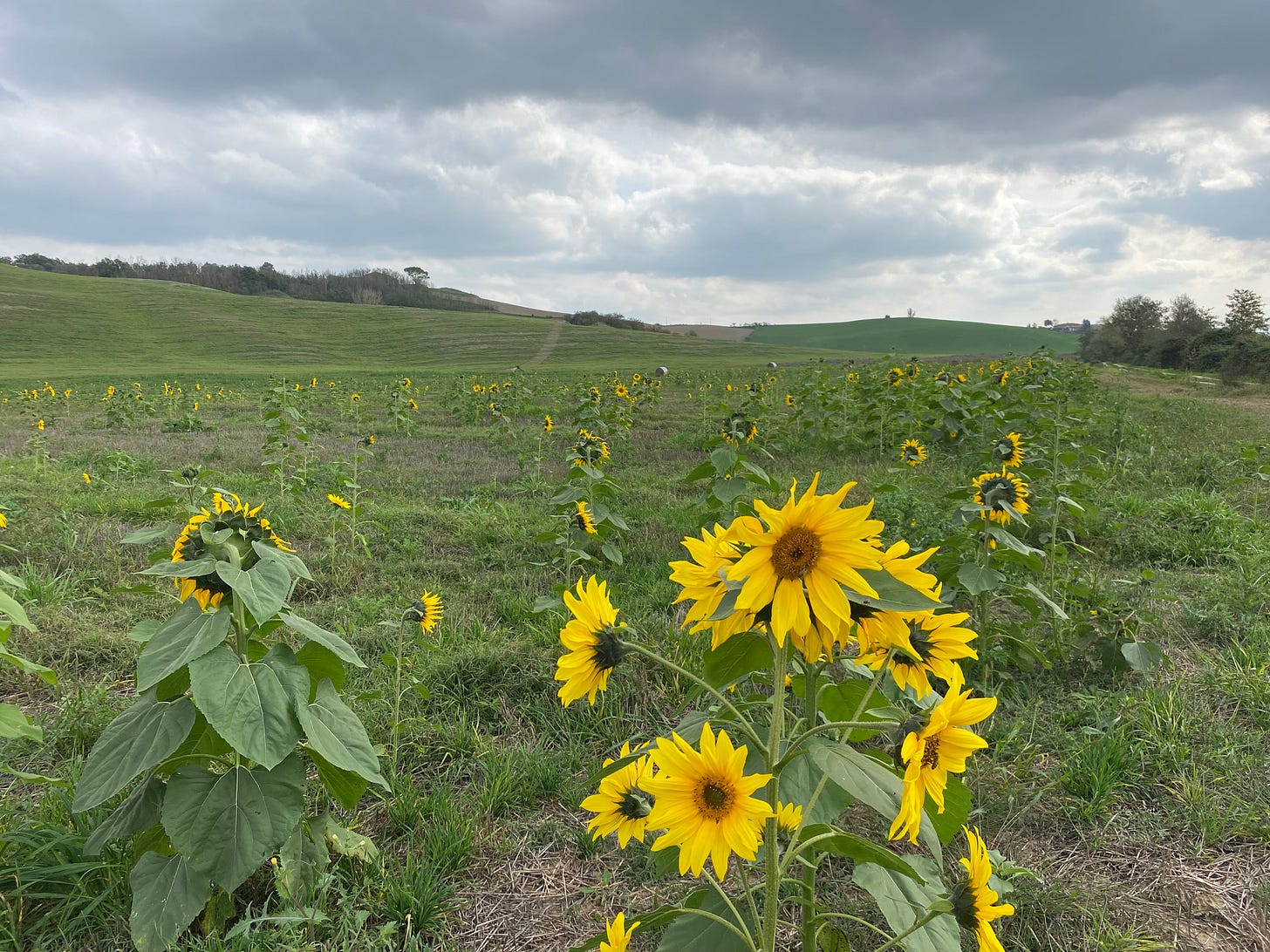
This is transporting. Riveting. Tear-producing. Hanging in the edge till next week…
Hi Tino, always great stories. It is interesting the feelings that were awakened within you when you started visiting Italy, that you knew that you belonged. In English “Morherland” captures that quite well. You and I and millions of others left our motherlands as children and lived wonderful lives elsewhere, but being back in the motherland awakens something. I was reminded, reading your story this morning, after I separated from my then wife I would go to my parent’s home for Sunday dinner. After a satisfying lunch that my mamma had served us, I would lie on the couch and have a nap. The feeling of security and comfort I felt being there was wonderful. When I visited San Vittore with my family , almost 20 years ago, walking around on a Sunday morning, the familiar cooking smells and our dialect being spoken, I truly felt at home. This is a bit corny, but to paraphrase some old saying “ You can leave Italy, but Italy never leaves you”.
Looking forward to next week. I used to read the Gazette religiously every Saturday morning, now I read you. Don’t stop😊.